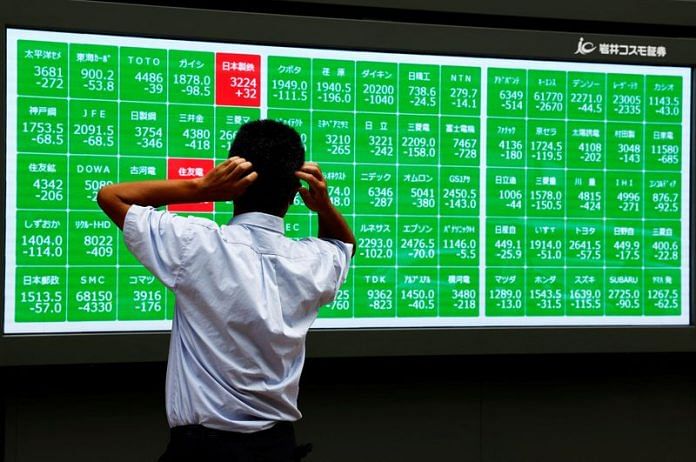By Wayne Cole
SYDNEY (Reuters) -Major share markets were deep under water in Asia on Monday as fears the United States could be heading for recession triggered mass risk aversion and wagers interest rates will have to fall sharply, and quickly, to support growth.
Investors stared where they finished on Friday by knocking Nasdaq futures down 1.64%, while S&P 500 futures dropped 1.04%.
MSCI’s broadest index of Asia-Pacific shares outside Japan lost 0.8%, while Japan’s Nikkei shed another 6.4% to hit seven-month lows.
Treasury bonds were in demand with 10-year yields down at 3.77%, the lowest since mid-2023.
Two-year yields sank 50 basis points last week to 3.85% and could soon slide below 10-year yields, turning the curve positive in a way that has heralded recessions in the past.
The worryingly weak July payrolls report saw markets price in a near 70% chance the Federal Reserve will not only cut rates in September, but ease by a full 50 basis points. Futures imply 155 basis points of cuts this year, with a similar amount in 2025.
“We have increased our 12-month recession odds by 10pp to 25%,” said analysts at Goldman Sachs in a note, though they thought the danger was limited by the sheer scope the Fed had to ease policy.
Goldman now expects quarter-point cuts in September, November, and December.
“The premise of our forecast is that job growth will recover in August and the FOMC will judge 25bp cuts a sufficient response to any downside risks,” they added. “If we are wrong and the August employment report is as weak as the July report, then a 50bp cut would be likely in September.”
Analysts at JPMorgan were even more bearish, subscribing a 50% probability to a U.S. recession.
“Now that the Fed looks to be materially behind the curve, we expect a 50bp cut at the September meeting, followed by another 50bp cut in November,” said economist Michael Feroli.
“Indeed, a case could be made for an inter-meeting easing, especially if the data soften further — although Fed officials might worry about how such a move could be (mis)interpreted.”
SEEKING SAFE HARBOURS
Investors will get a read on employment in the service sector from the ISM non-manufacturing survey due later Monday and analysts are hoping for a rebound to 51.0 after June’s unexpected slide to 48.8.
This week has earnings from industrial bellwether Caterpillar and media giant Walt Disney, which will give more insight into the state of the consumer and manufacturing. Also reporting are healthcare heavyweights such as weight-loss drugmaker Eli Lilly.
The huge drop in Treasury yields had also overshadowed the U.S. dollar’s usual safe-haven appeal and dragged the currency down around 1% on Friday.
Early Monday, the dollar was down another 0.4% on the Japanese yen at 145.90, while the euro was holding steady at $1.0909.
The Swiss franc was a major beneficiary of the rush from risk, with the dollar near six-month lows at 0.8571 francs.
“The shift in expected interest rate differentials against the U.S. has outweighed the deterioration in risk sentiment,” said Jonas Goltermann, deputy chief markets economist at Capital Economics.
“If the recession narrative takes hold in earnest, we would expect that to change, and the dollar to rebound as safe-haven demand becomes the dominant driver in currency markets.”
Investors had also increased wagers other major central banks would follow the Fed’s lead and ease more aggressively, with the European Central Bank now seen cutting by 67 basis points by Christmas.
In commodity markets, gold pulled back to $2,421 an ounce, perhaps undermined by investors taking profits to cover losses elsewhere. [GOL/]
Oil prices bounced amid concerns about a widening conflict in the Middle East, though worries about demand had seen it sink to eight-month lows last week. [O/R]
Brent gained 27 cents to $77.08 a barrel, while U.S. crude rose 23 cents to $73.75 per barrel.
(Reporting by Wayne Cole; Editing by Stephen Coates)
Disclaimer: This report is auto generated from the Reuters news service. ThePrint holds no responsibilty for its content.



